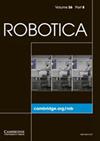基于人工神经网络的动力膝关节外骨骼起重任务控制:设计与实验验证
IF 2.7
4区 计算机科学
Q3 ROBOTICS
引用次数: 0
摘要
本研究介绍了一种混合模型,该模型利用基于模型的优化方法生成训练数据,并利用基于人工神经网络(ANN)的学习方法为起重活动提供实时外骨骼支持。在基于模型的优化方法中,利用二维(2D)人体-外骨骼模型预测膝关节外骨骼的扭矩和最佳提举运动。外骨骼电机电流曲线控制点和立方 B-样条插值法得出的人体关节角度曲线控制点代表设计变量。最小化归一化人体关节扭矩的平方被视为成本函数。随后,利用稀疏非线性优化器(SNOPT)中的顺序二次编程(SQP)算法解决提升优化问题。在基于学习的方法中,使用一般回归神经网络(GRNN)训练基于学习的控制模型。人体的人体测量参数和提升边界姿势作为输入参数,外骨骼扭矩控制点作为输出参数。经过训练后,基于学习的控制模型就能为举重任务实时提供外骨骼辅助扭矩。实验结果与模拟结果之间存在两个测试对象的关节角度和地面反作用力(GRFs)比较。此外,与不使用外骨骼的情况相比,使用外骨骼可显著降低两名受试者膝关节四块伸屈肌的激活率。总之,与基于模型的优化控制方法相比,基于学习的控制方法能更快地实时生成辅助扭矩曲线。本文章由计算机程序翻译,如有差异,请以英文原文为准。
Artificial neural network-based control of powered knee exoskeletons for lifting tasks: design and experimental validation
This study introduces a hybrid model that utilizes a model-based optimization method to generate training data and an artificial neural network (ANN)-based learning method to offer real-time exoskeleton support in lifting activities. For the model-based optimization method, the torque of the knee exoskeleton and the optimal lifting motion are predicted utilizing a two-dimensional (2D) human–exoskeleton model. The control points for exoskeleton motor current profiles and human joint angle profiles from cubic B-spline interpolation represent the design variables. Minimizing the square of the normalized human joint torque is considered as the cost function. Subsequently, the lifting optimization problem is tackled using a sequential quadratic programming (SQP) algorithm in sparse nonlinear optimizer (SNOPT). For the learning-based approach, the learning-based control model is trained using the general regression neural network (GRNN). The anthropometric parameters of the human subjects and lifting boundary postures are used as input parameters, while the control points for exoskeleton torque are treated as output parameters. Once trained, the learning-based control model can provide exoskeleton assistive torque in real time for lifting tasks. Two test subjects’ joint angles and ground reaction forces (GRFs) comparisons are presented between the experimental and simulation results. Furthermore, the utilization of exoskeletons significantly reduces activations of the four knee extensor and flexor muscles compared to lifting without the exoskeletons for both subjects. Overall, the learning-based control method can generate assistive torque profiles in real time and faster than the model-based optimal control approach.
求助全文
通过发布文献求助,成功后即可免费获取论文全文。
去求助
来源期刊

Robotica
工程技术-机器人学
CiteScore
4.50
自引率
22.20%
发文量
181
审稿时长
9.9 months
期刊介绍:
Robotica is a forum for the multidisciplinary subject of robotics and encourages developments, applications and research in this important field of automation and robotics with regard to industry, health, education and economic and social aspects of relevance. Coverage includes activities in hostile environments, applications in the service and manufacturing industries, biological robotics, dynamics and kinematics involved in robot design and uses, on-line robots, robot task planning, rehabilitation robotics, sensory perception, software in the widest sense, particularly in respect of programming languages and links with CAD/CAM systems, telerobotics and various other areas. In addition, interest is focused on various Artificial Intelligence topics of theoretical and practical interest.
 求助内容:
求助内容: 应助结果提醒方式:
应助结果提醒方式:


